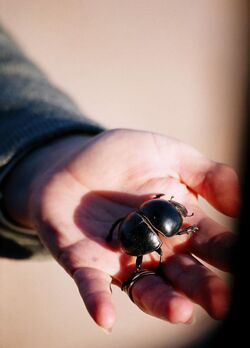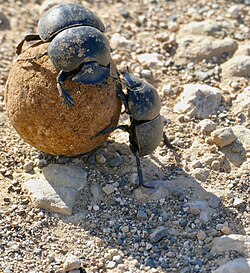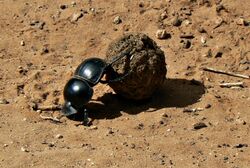Biology:Flightless dung beetle
| Flightless dung beetle | |
|---|---|

| |

| |
| Both from Addo Elephant National Park in Eastern Cape, South Africa | |
| Scientific classification | |
| Kingdom: | |
| Phylum: | |
| Class: | |
| Order: | |
| Family: | |
| Subfamily: | |
| Tribe: | |
| Genus: | Circellium Latreille, 1825
|
| Species: | C. bacchus
|
| Binomial name | |
| Circellium bacchus (Fabricius, 1781)
| |
The flightless dung beetle (Circellium bacchus) is a species of dung beetle endemic to a few areas of South Africa , including the Addo Elephant National Park, Amakhala Game Reserve and the Buffalo Valley Game Farm.[1] It is the only species in the genus Circellium.[2] The loss of flight allows the beetle to use the empty space below the elytra as a carbon dioxide storage tank, creating a unique breathing mechanism which conserves water, a valuable survival trait in the arid regions it lives in.[2][3][4]
The species was originally widespread in Southern Africa, but it only survives in the few areas mentioned above; as such, it qualifies as an IUCN vulnerable species. Its vulnerability is exacerbated by a number of other factors, including the fact that its habitat is under threat by agriculture and human activity, that it has low breeding capacity as well as low dispersability (as a consequence of being flightless), and that its survival is strictly dependent on a number of vertebrates (particularly elephant and buffalo) that are also experiencing a decrease in population.[1] File:Dung beetle working-001.ogv The flightless dung beetles mostly feed on elephant or buffalo faeces, but they have been recorded to also feed on dung from other species such as rabbits, baboons, antelopes, and ostriches.[1]
References
- ↑ 1.0 1.1 1.2 "Circellium bacchus (Flightless dung beetle, Addo flightless dung beetle)". Biodiversity Explorer. http://www.biodiversityexplorer.org/beetles/scarabaeidae/scarabaeinae/circellium_bacchus.htm. Retrieved October 16, 2010.
- ↑ 2.0 2.1 Steven L. Chown, Pierre Pistorius & Clarke H. Scholtz (1998). "Morphological correlates of flightlessness in southern African Scarabaeinae (Coleoptera: Scarabaeidae): testing a condition of the water-conservation hypothesis" (PDF). Canadian Journal of Zoology 76 (6): 1123–1133. doi:10.1139/z98-036. http://pubs.nrc-cnrc.gc.ca/journals.old/cjz/cjz76/z98-036.pdf.[yes|permanent dead link|dead link}}]
- ↑ Roger Santer (2003). "Dung Beetles Turn in Wings for a Long, Dry Walk" (PDF). Journal of Experimental Biology 206: 1261–1262. doi:10.1242/jeb.00269. http://jeb.biologists.org/content/206/8/1261.2.full.pdf.
- ↑ Marcus J. Byrne and Frances D. Duncan (2003). "The role of the subelytral spiracles in respiration in the flightless dung beetle Circellium bacchus" (PDF). Journal of Experimental Biology 206: 1309–1318. doi:10.1242/jeb.00250. http://jeb.biologists.org/content/206/8/1261.2.full.pdf.
External links
- Roger Santer (2006). "Dung beetles turn in wings for a long, dry walk". Journal of Experimental Biology 206: 1261–1262. doi:10.1242/jeb.00269.
Wikidata ☰ Q1083045 entry
 |


